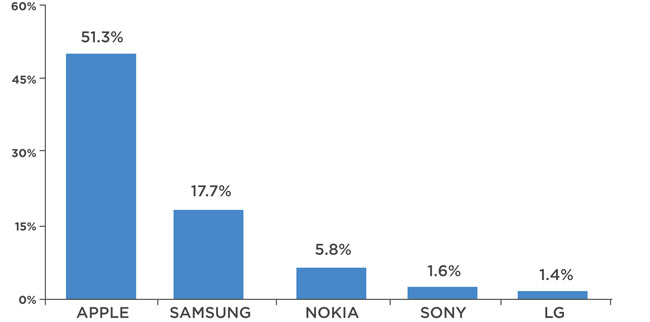Apple Devices Dominated Christmas this Year

The Winter Solstice Holiday we call Christmas has come and gone, the gifts unwrapped, the shelf un-elfed, the nog egged. While in years past we’d have to petition retailers and gift-givers about what the most-given gadgets might have been, many of the tech-toys under the tree these days connect to the Internet, giving us a new way to figure out who got what. Based on that information, it seems that 2014 was Apple’s year.
According to Flurry Insights, a mobile analytics firm, over 51 percent of new mobile devices activated on Christmas Day were Apple-made, driven primarily by the September-released iPhone 6 and iPhone 6 Plus. In a distant second were devices made by Samsung running Android, accounting for nearly 18 percent of new device activations. Considering that the rest of the devices on Flurry’s top five list all sit in the single digits – Nokia at nearly 6 percent, Sony at 1.6 percent, and LG at 1.4 percent – 18 percent is nothing to sneeze at. However, I’m sure it’s still cold comfort for Samsung’s struggling mobile execs to see that their devices came in at number two with a gap of over 30 percent. The report also says that Xiaomi, Huawei, and HTC all enjoyed less than one percent device activation that day, though these brands are more popular in parts of the planet where Christmas Day doesn’t hold nearly as much significance as it does in the Western World.
The report offers up a nice description to make the numbers more plain:
“To put this in perspective, for every Samsung devices that was activated, Apple activated 2.9 devices. For every Microsoft Lumia device activated, Apple activated 8.8 devices.”
In short, Apple killed it this Christmas, which is annually the biggest device-activation day of the year. The implications are more wide-reaching than Apple’s bottom line, too. Numbers like this will keep ecosystem trends developing along their current lines; in other words, app developers who move towards iOS first (or exclusively) over Android or Windows Phone will continue along that course. Android may have a bigger app library, but the newest and best apps will still stay on iPhones and iPads for some time to come. The same can be said for premium accessories, like keyboards, cases, and external battery packs. Google’s decision to allow Android to be fragmented among many manufacturers may offer users lots of choices, but in the end, Apple’s all-encompassing strategy is working wonders for them, and shows no sign of ceasing to do so.
[Source: Flurry Insights]